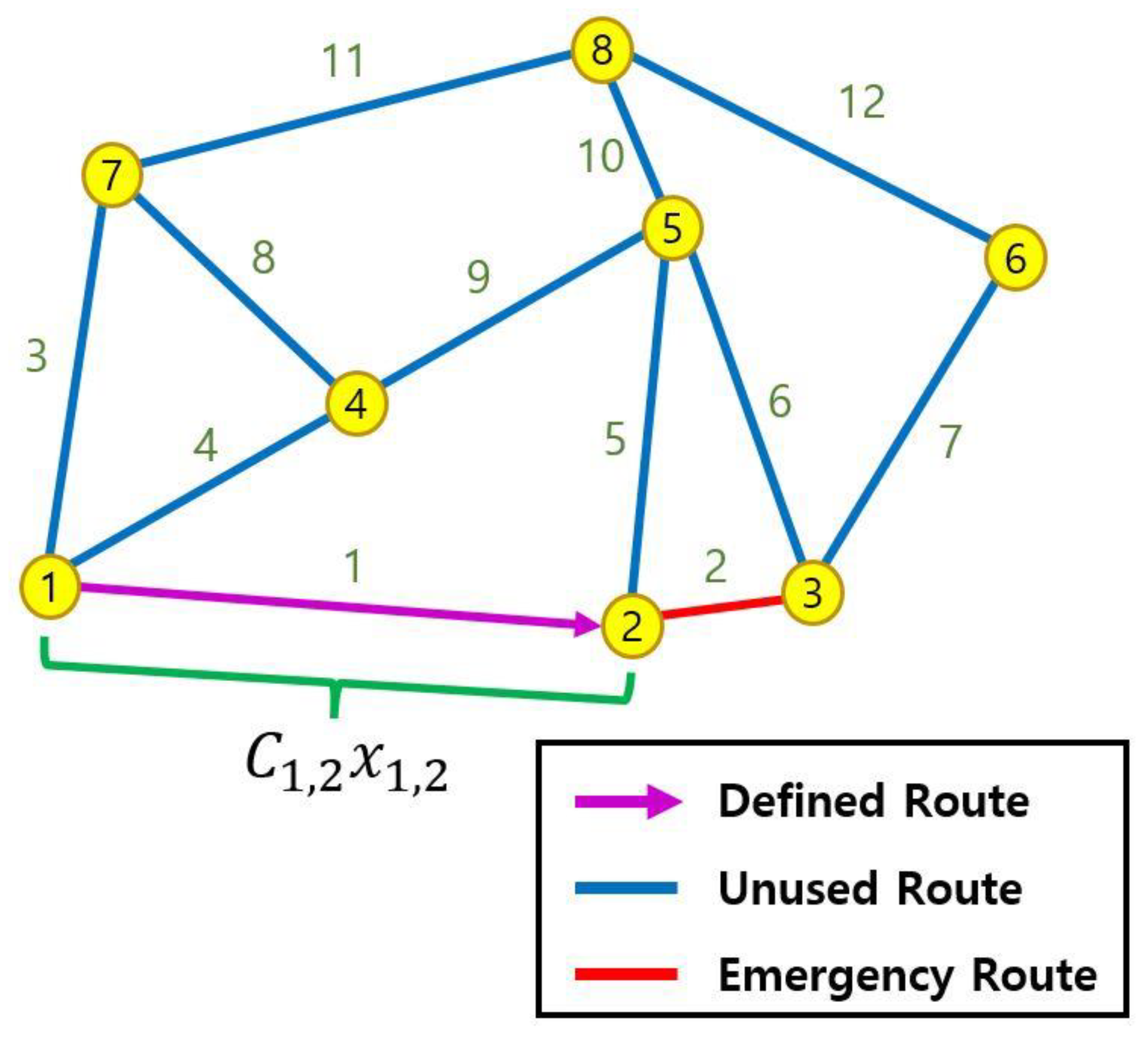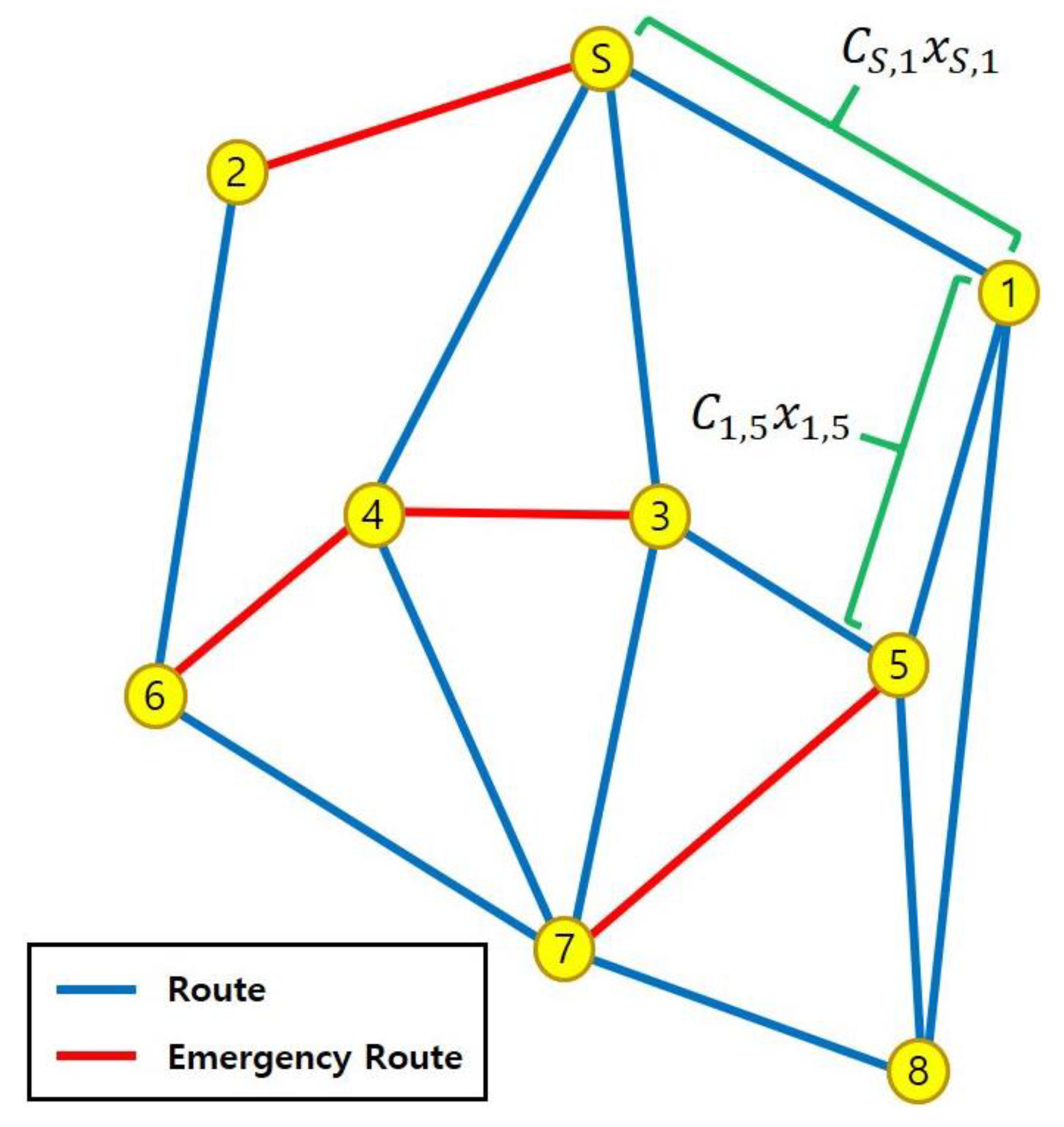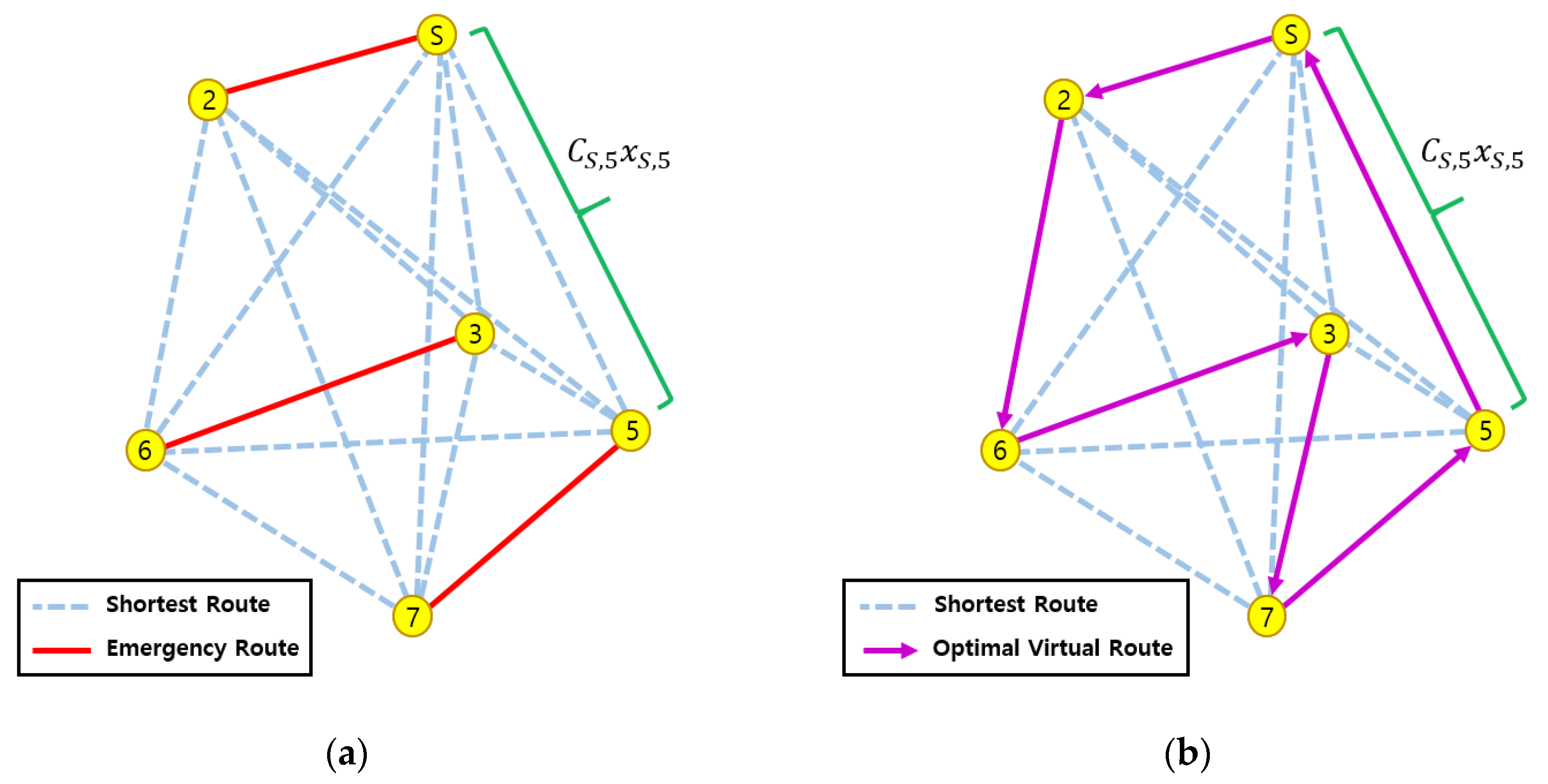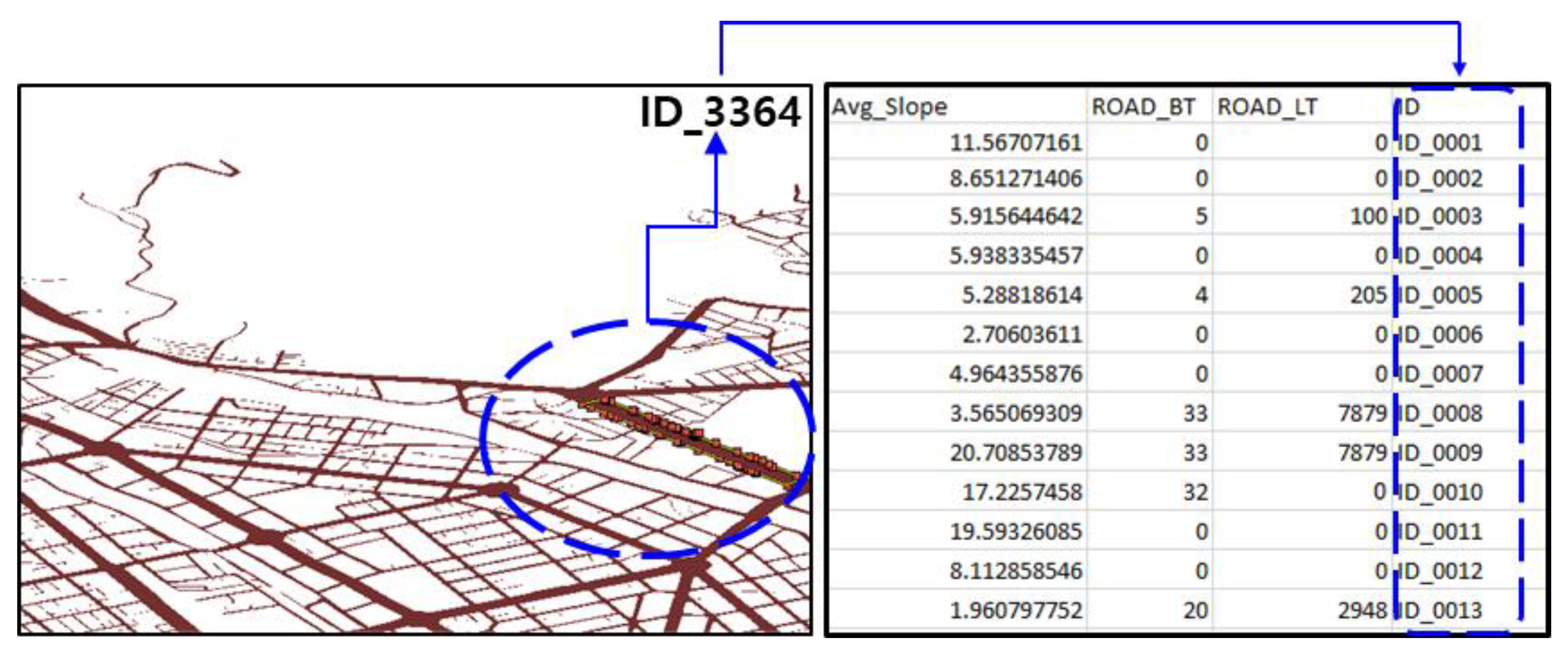CityGML-Based Road Information Model for Route Optimization of Snow-Removal Vehicle
Abstract
:1. Introduction
2. Related Works
2.1. Optimal-Route Calculation Theory
2.2. Three-Dimensional (3D) City Model
3. Methodology
3.1. Factors Relevant to Roads Vulnerable to Snow Removal
3.2. CityGML-Based 3D Road-Information Model
3.2.1. CityGML Transportation Model
3.2.2. Generation of the Terrain-Based Road Model
3.2.3. Slope Analysis Using the CityGML Model
3.3. Improved Algorithm Considering Snow-Vulnerable Areas
3.3.1. Problem Formularization for Optimal Route Estimation
3.3.2. Virtual Route Algorithm
4. Verification of Optimal Route Calculation for a Real Area
4.1. Scenario Analysis
4.2. Road Network Formation
4.3. Optimal Route Estimation
5. Conclusions
Author Contributions
Funding
Acknowledgments
Conflicts of Interest
References
- Biljecki, F.; Stoter, J.; Ledoux, H.; Zlatanova, S.; Çöltekin, A. Applications of 3D city models: State of the art review. ISPRS Int. J. Geo Inf. 2015, 4, 2842–2889. [Google Scholar] [CrossRef] [Green Version]
- Kolbe, T.H.; Gröger, G.; Plümer, L. CityGML: Interoperable access to 3D city models. In Geo-Information for Disaster Management; Springer: Berlin, Germany, 2005; pp. 883–899. [Google Scholar]
- Massaâbi, M.; Layouni, O.; Oueslati, W.B.M.; Alahmari, F. An Immersive System for 3D Floods Visualization and Analysis. In Proceedings of the International Conference on Immersive Learning, Missoula, MT, USA, 24–29 June 2018; pp. 69–79. [Google Scholar]
- Redweik, P.; Teves-Costa, P.; Vilas-Boas, I.; Santos, T. 3D city models as a visual support tool for the analysis of buildings seismic vulnerability: The case of Lisbon. Int. J. Disaster Risk Sci. 2017, 8, 308–325. [Google Scholar] [CrossRef] [Green Version]
- Zhou, Q.; Sun, B.T.; Yan, P.L.; Zhao, P. Study on simulation technology of earthquake disaster scene. In Proceedings of the Advanced Materials Research, Chongqing, China, 21–23 January 2011; pp. 5111–5114. [Google Scholar]
- Irizarry, J.; Karan, E.P. Optimizing location of tower cranes on construction sites through GIS and BIM integration. J. Inf. Technol. Constr. (ITcon) 2012, 17, 351–366. [Google Scholar]
- Gröger, G.; Plümer, L. CityGML–Interoperable semantic 3D city models. ISPRS J. Photogramm. Remote Sens. 2012, 71, 12–33. [Google Scholar] [CrossRef]
- Kar, B.; Hodgson, M.E. A GIS-based model to determine site suitability of emergency evacuation shelters. Trans. GIS 2008, 12, 227–248. [Google Scholar] [CrossRef]
- Lee, S.-H.; Park, J.; Park, S.I. City Information Model-Based Damage Estimation in Inundation Condition. In Proceedings of the International Conference on Computing in Civil and Building Engineering (ICCCBE 2016), Osaka, Japan, 5–8 July 2016; pp. 1038–1043. [Google Scholar]
- Labetski, A.; van Gerwen, S.; Tamminga, G.; Ledoux, H.; Stoter, J. A proposal for an improved transportation model in CityGML. Int. Arch. Photogramm. Remote Sens. Spat. Inf. Sci. 2018, XLII-4/W10, 89–96. [Google Scholar] [CrossRef] [Green Version]
- Open Geospatial Consortium. OGC City Geography Markup Language (CityGML) Encoding Standard 2.0.0; Open Geospatial Consortium: Wayland, MA, USA, 2012. [Google Scholar]
- Schröder, M.; Cabral, P. Eco-friendly 3D-Routing: A GIS based 3D-Routing-Model to estimate and reduce CO2-emissions of distribution transports. Comput. Environ. Urban Syst. 2019, 73, 40–55. [Google Scholar] [CrossRef] [Green Version]
- Tavares, G.; Zsigraiova, Z.; Semiao, V.; Carvalho, M.D.G. Optimisation of MSW collection routes for minimum fuel consumption using 3D GIS modelling. Waste Manag. 2009, 29, 1176–1185. [Google Scholar] [CrossRef]
- Perrier, N.; Langevin, A.; Amaya, C.-A. Vehicle routing for urban snow plowing operations. Transport. Sci. 2008, 42, 44–56. [Google Scholar] [CrossRef] [Green Version]
- Xie, B.; Li, Y.; Jin, L. Vehicle routing optimization for deicing salt spreading in winter highway maintenance. Procd. Soc. Behv. 2013, 96, 945–953. [Google Scholar] [CrossRef] [Green Version]
- Ahmadi, E.; Süer, G.A.; Al-Ogaili, F. Solving Stochastic Shortest Distance Path Problem by Using Genetic Algorithms. Procedia. Comput. Sci. 2018, 140, 79–86. [Google Scholar] [CrossRef]
- Hassanzadeh, R.; Mahdavi, I.; Mahdavi-Amiri, N.; Tajdin, A. A genetic algorithm for solving fuzzy shortest path problems with mixed fuzzy arc lengths. Math. Comput. Model. 2013, 57, 84–99. [Google Scholar] [CrossRef]
- Mohamed, C.; Bassem, J.; Taicir, L. A genetic algorithms to solve the bicriteria shortest path problem. Electron. Notes Discret. Math. 2010, 36, 851–858. [Google Scholar] [CrossRef]
- Zhu, X.; Luo, W.; Zhu, T. An improved genetic algorithm for dynamic shortest path problems. In Proceedings of the 2014 IEEE Congress on Evolutionary Computation (CEC), Beijing, China, 6–11 July 2014; pp. 2093–2100. [Google Scholar]
- Lawler, E.L.; Lenstra, J.K.; Rinnooy Kan, A.H.; Shmoys, D.B. The Traveling Salesman Problem; a Guided Tour of Combinatorial Optimization; Wiley: Chichester, UK, 1985. [Google Scholar]
- Hacizade, U.; Kaya, I. GA based traveling salesman problem solution and its application to transport routes optimization. IFAC PapersonLine 2018, 51, 620–625. [Google Scholar] [CrossRef]
- Sakakibara, K. New edges not used in shortest tours of TSP. Eur. J. Oper. Res. 1998, 104, 129–138. [Google Scholar] [CrossRef]
- Kwon, S.-H.; Kim, H.-T.; Kang, M.-K. Determination of the candidate arc set for the asymmetric traveling salesman problem. Comput. Oper. Res. 2005, 32, 1045–1057. [Google Scholar] [CrossRef]
- Wikipedia—Heuristic Routing. Available online: https://en.wikipedia.org/wiki/Heuristic_routing (accessed on 10 December 2019).
- Saka, M.P.; Hasançebi, O.; Geem, Z.W. Metaheuristics instructural optimization and discussions on harmony search algorithm. Swarm. Evol. Comput. 2016, 28, 88–97. [Google Scholar] [CrossRef]
- Geem, Z.W.; Kim, J.H.; Loganathan, G.V. A new heuristic optimization algorithm: Harmony search. Simulation 2001, 76, 60–68. [Google Scholar] [CrossRef]
- Kirkpatrick, S.; Gelet, C.D.; Vecchi, M.P. Optimization by simulated annealing Optimization. Science 1983, 220, 621–630. [Google Scholar] [CrossRef]
- Glover, F. Tabu Search—Part I. Informs. J. Comput. 1989, 1, 190–206. [Google Scholar] [CrossRef]
- Glover, F. Tabu Search—Part II. Informs. J. Comput. 1990, 2, 4–32. [Google Scholar] [CrossRef]
- Geem, Z.W. Optimal cost design of water distribution networks using harmony search. Eng. Optimiz. 2006, 38, 259–280. [Google Scholar] [CrossRef]
- Geem, Z.W. Optimal scheduling of multiple dam system using harmony search algorithm. Lect. Notes Comput. Sci. 2007, 4507, 316–323. [Google Scholar]
- Zhang, J.-Y.; Li, J. A heuristic algorithm to vehicle routing problem with the consideration of customers’ service preference. In Proceedings of the 8th International Conference on Service Systems and Service Management, Tianjin, China, 25–27 June 2011; pp. 1–6. [Google Scholar]
- Roh, W.H. A Study of Workload Balancing for Nurse Schedule Using Genetic Algorithm: Based on Military Hospital. Master’s Thesis, Yonsei University, Seoul, Korea, 2005. [Google Scholar]
- Information Resources Management Association. Architecture and Design: Breakthroughs in Research and Practice; IGI Global: Hershey, PA, USA, 2018; p. 1385. [Google Scholar]
- Wate, P.S. 3D GIS Modeling at Semantic Level Using CityGML for Urban Segment. Master’s Thesis, Andhra University, Uttarakhand, India, 2014. [Google Scholar]
- Vitalis, S.; Ohori, K.A.; Stoter, J. Incorporating Topological Representation in 3D City Models. ISPRS Int. J. Geo-Inf. 2019, 8, 347. [Google Scholar] [CrossRef] [Green Version]
- Buyukaslih, I.; Isikdag, U.; Zlatanova, S. Exploring the processes of generating LOD (0-2) CityGML models in greater municipality of Istanbul. In Proceedings of the 8th 3DGeoInfo Conference & WG II/2 Workshop, Istanbul, Turkey, 27–29 November 2013; pp. 19–24. [Google Scholar]
- Buyukdemircioglu, M.; Kocaman, S.; Isikdag, U. Semi-automatic 3D city model generation from large-format aerial images. ISPRS Int. J. Geo Inf. 2018, 7, 339. [Google Scholar] [CrossRef] [Green Version]
- Atila, U.; Karas, I.R.; Turan, M.K.; Rahman, A.A. Automatic generation of 3D networks in CityGML and design of an intelligent individual evacuation model for building fires within the scope of 3D GIS. 3D Geo Inf. Sci. 2014, 123–142. [Google Scholar] [CrossRef]
- Dutta, A.; Saran, S.; Kumar, A.S. Development of CityGML application domain extension for indoor routing and positioning. J. Indian Soc. Remote Sens. 2017, 45, 993–1004. [Google Scholar] [CrossRef]
- Kim, K.; Wilson, J.P. Planning and visualising 3D routes for indoor and outdoor spaces using CityEngine. J. Spat. Sci. 2015, 60, 179–193. [Google Scholar] [CrossRef]
- Chung, Y.S.; Lee, J.; Lee, H.S.; Ahn, H.-R.; Park, T.-W. A Preliminary Study on Selection Criteria of Disaster Operation Routes Considering Disaster Types and Roadway Characteristics; the Korea Transport Institute: Sejong, Korea, 2015; pp. 1–208. [Google Scholar]
- Disaster Routes—Los Angeles County Operational Area. Available online: https://dpw.lacounty.gov/dsg/DisasterRoutes/ (accessed on 27 September 2019).
- IPCC. Climate Change 2014: Mitigation of Climate Change; Cambridge University Press: New York, NY, USA, 2014. [Google Scholar]
- Won, J.-S.; Bae, Y.-S.; Kim, S.-G. A Study on Urban Snow Removal and Disposal in Seoul: Focused on Local Roads; the Seoul Institute: Seoul, Korea, 2014; pp. 1–173. [Google Scholar]
- The Korea Expressway Corporation. Freeway Disaster Management Manual; The Korea Expressway Corporation: Gimcheon, Korea, 2010. [Google Scholar]
- The Korea Expressway Corporation. Study on Establishing Highway Road Weather Information System; The Korea Expressway Corporation: Gimcheon, Korea, 2010. [Google Scholar]
- Yang, J.; Sun, H.; Wang, L.; Li, L.; Wu, B. Vulnerability evaluation of the highway transportation system against meteorological disasters. Procd. Soc. Behv. 2013, 96, 280–293. [Google Scholar] [CrossRef] [Green Version]
- Kim, Y.R.; Yoon, C. A study of vulnerable roadway section determining method for snow removal using a GIS. GJESR 2016, 3, 63–71. [Google Scholar]
- McCarthy, J.J.; Canziani, O.F.; Leary, N.A.; Dokken, D.J.; White, K.S. Climate Change 2001: Impacts, Adaptation, and Vulnerability: Contribution of Working Group II to the Third Assessment Report of the Intergovernmental Panel on Climate Change; Cambridge University Press: London, UK, 2001; pp. 1–1042. [Google Scholar]
- Tapia, C.; Abajo, B.; Feliu, E.; Mendizabal, M.; Martinez, J.A.; Fernández, J.G.; Laburu, T.; Lejarazu, A. Profiling urban vulnerabilities to climate change: An indicator-based vulnerability assessment for European cities. Ecol. Indic. 2017, 78, 142–155. [Google Scholar] [CrossRef]
- Jeju Special Self-Governing Province. Snow Removal Manual for Winter Snow Removal; The Road Management Office: Jeju, Korea, 2008.
- Beil, C.; Kolbe, T.H. CityGML and the streets of New York-A proposal for detailed street space modelling. In Proceedings of the 12th International 3D GeoInfo Conference 2017, Melbourne, Australia, 26–27 October 2017; pp. 9–16. [Google Scholar]
- Floros, G.; Dimopoulou, E. Investigating the enrichment of a 3d city model with various CityGML modules. Int. Arch. Photogramm. Remote Sens. Spat. Inf. Sci. 2016, XLII-2/W2, 3–9. [Google Scholar] [CrossRef] [Green Version]
- Floyd, R.W. Algorithm 97: Shortest path. Commun. ACM 1962, 5, 345. [Google Scholar] [CrossRef]
- Warshall, S. A theorem on Boolean matrices. J. ACM 1962, 9, 11–12. [Google Scholar] [CrossRef]
- Ministry of Land, Infrastructure and Transport. Rules for the Decision, Structure, and Installation Standards of Urban Planning Facilities; Ministry of Land, Infrastructure and Transport: Sejong, Korea, 2009.
- National Emergency Management Agency. Advanced Snow Removal System and Customized Snow Removal Plan; National Emergency Management Agency: Sejong, Korea, 2010; pp. 1–208.
- Dijkstra, E.W. A note on two problems in connexion with graphs. Numer. Math. 1959, 1, 269–271. [Google Scholar] [CrossRef] [Green Version]

















| Disaster Route | Snow Vulnerability |
|---|---|
| Many lanes | Road direction |
| No central reserve, road shoulder, and sloping surfaces | Strong sunlight |
| Low slope | High slope |
| Roads without bridges and tunnels | Roads without vulnerable spots |
| No speed limit | Shady place |
| Low traffic volume | High traffic volume |
| Contain roadside information provision device | |
| Many links |
| Regulator Stage | Deicer Input (kg) | Outlet Size (mm) | Effective Spray Width (mm) | Maximum Spray Width (mm) | Spray Duration (min) |
|---|---|---|---|---|---|
| First stage | 250 | 25 | 2000 | 3000 | 60 |
| Fifth stage | 250 | 25 | 4500 | 6100 | 30 |
| Ninth stage | 250 | 25 | 6200 | 10000 | 10 |
| Road Network | Target Range | Maximum Location from Snow-Removal Base (Estimated Using the Dijkstra Algorithm) |
| Target road | Roads having widths of 20 m or higher (corresponding to roads of class 2 or higher, as per the Ministry of Land, Infrastructure and Transport (Korea)) | |
| Constraints | 4% slope to ensure the necessary passing conditions for emergency roads |
© 2019 by the authors. Licensee MDPI, Basel, Switzerland. This article is an open access article distributed under the terms and conditions of the Creative Commons Attribution (CC BY) license (http://creativecommons.org/licenses/by/4.0/).
Share and Cite
Park, S.H.; Jang, Y.-H.; Geem, Z.W.; Lee, S.-H. CityGML-Based Road Information Model for Route Optimization of Snow-Removal Vehicle. ISPRS Int. J. Geo-Inf. 2019, 8, 588. https://0-doi-org.brum.beds.ac.uk/10.3390/ijgi8120588
Park SH, Jang Y-H, Geem ZW, Lee S-H. CityGML-Based Road Information Model for Route Optimization of Snow-Removal Vehicle. ISPRS International Journal of Geo-Information. 2019; 8(12):588. https://0-doi-org.brum.beds.ac.uk/10.3390/ijgi8120588
Chicago/Turabian StylePark, Sang Ho, Young-Hoon Jang, Zong Woo Geem, and Sang-Ho Lee. 2019. "CityGML-Based Road Information Model for Route Optimization of Snow-Removal Vehicle" ISPRS International Journal of Geo-Information 8, no. 12: 588. https://0-doi-org.brum.beds.ac.uk/10.3390/ijgi8120588






